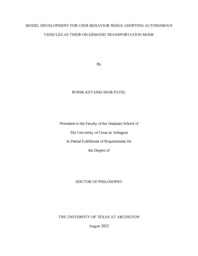| dc.description.abstract | Shared autonomous vehicles (SAVs) are a new technology that allows passengers to skip hailing a cab using a smartphone app to summon an autonomous shuttle that does not require a human operator. SAVs are anticipated to improve the efficiency, mobility, safety, and affordability of transportation systems. However, consumers will determine the success of SAV technology. Researchers have studied the associations between individuals' attitudes, preferences, and adoption of self-driving services focusing mainly on potential riders with no actual ridership experience. However, the literature lacks empirical assessments of riders' adoption and acceptance of SAVs. Therefore, this study aims to develop two models identifying the factors impacting: 1) users frequency of using SAVs; and 2) users and non-users willingness to use SAVs in the future. The first model identifies the factors impacting the users frequency of using SAVs using structural equation modeling (SEM) based on data collected from a short ridership survey distributed among the users of a self-driving pilot project. Model 1 results indicated that race, trip purpose, waiting time, and the availability of a private vehicle significantly influence the frequency of using SAVs. The second model identifies the factors impacting the users and non-users willingness to ride the SAVs based on the data collected from a comprehensive survey distributed among users and non-users. Model 2 results suggested that the frequency of using SAVs directly impacts willingness to use SAVs, and sociodemographic attributes of the SAV riders indirectly influence willingness to use SAVs through the mediators, including RAPID usage, existing modes of transportation, and vehicle ownership. Moreover, this study aims to develop an ordinal logistics regression (OLR) model to analyze the impact of users and non-users attitudes towards SAVs on their willingness to use SAVs using the data from the comprehensive survey. The result from the OLR model indicated that ease of using SAVs positively impacts willingness to use SAVs in the future, and safety concerns about SAV technology negatively impact willingness to use SAVs in the future. This study also aims to provide in-depth insights into perceptions, attitudes, preferences, and concerns of users and non-users of the SAV technology using the qualitative data collected from focus groups and personal interviews. The content analysis of the focus group revealed that participants with visual impairment anticipated that future SAV services would enhance their mobility through advanced apps, booking systems, and vehicle equipment. The content analysis of interviews indicated that waiting time, pick-up and drop-off locations, and the ability to make tight turns at the intersection are the three major concerns related to SAVs. Moreover, potential riders anticipate that SAVs will be cost-efficient, environmentally friendly, and safer than human-operated vehicles. This study provides crucial insights into individual travel behavior after integrating SAVs with existing transportation systems which will help local, state, and government transit agencies to develop policies and a transportation infrastructure that will enhance SAV operations universally. The findings of this study offer several implications for designing future SAV services in line with the needs of persons with disabilities. Moreover, this study provides insights into the perceptions and attitudes of SAV users and non-users and identifies strategies for successfully integrating an SAV service with an existing on-demand ridesharing service. | |


